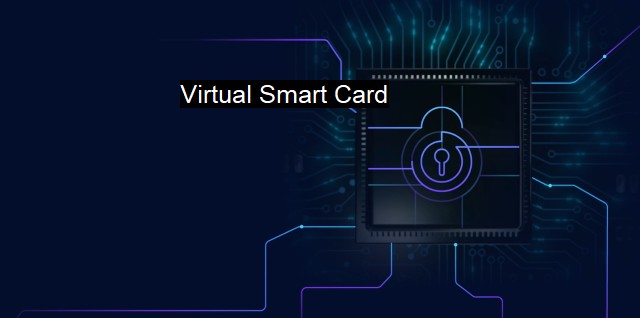What is Virtual Smart Card?
Securing the Future with Virtual Smart Cards: Exploring their Role in Cybersecurity and Antivirus Protection
Virtual smart cards are innovative cybersecurity tools that provide a safe environment for activities requiring sensitive information by emulating physical smart cards. They deliver the functionality of smart card technology but without any additional peripheral devices.Smart cards are a long-established technology embedded with computer chips for storing sensitive data such as user credentials. Virtual smart cards essentially store those credentials inside a secured, tamper-proof area of a computer’s main chip, with the software then interpreting this stored information as if it was received from a physical card.
Virtual smart cards are a step forward from their physical counterparts for various reasons. The first is their affordability; there’s no requirement for additional hardware since virtual smart cards use existing systems. Their provisioning, aimed from a management perspective, offers better flexibility and efficiency. Plus, there is no risk of losing or damaging physical cards, eliminating consequent security risks.
Virtual smart cards can be divided into two broad categories, Embodied Virtual Smart Cards (EVSCs) and Disembodied Virtual Smart Cards (DVSCs). EVSCs load and store data on an existing physical card, while DVSCs do not have a physical presence and are therefore more abstract but are equally effective in maintaining the safety of operations.
Encryption is one security measure applied to virtual smart cards. Encryption scrambles the data into an unreadable format, which mitigates the risks of data breach effectively, and tests have revealed the security standards of virtual smart cards to be no less than their physical counterparts.
Virtual smart cards can also lend an extra layer of protection against threats such as keystroke logging. Even if a perpetrator manages to log the keystrokes of a password, the credentials will still be meaningless as they will lack access to the tamper-proof area where the information is securely stored. This setup makes virtual smart cards compatible with systems requiring high levels of data protection.
Two-factor authentication is another security measure employed by virtual smart cards. It adds another layer of security, ensuring that even if passwords are compromised, the perpetrator will not gain access without successfully passing through another form of verification, such as fingerprint recognition or a token.
In specific applications, virtual smart cards can also serve to improve organisation cybersecurity by implementing Role-Based Access Control (RBAC). RBAC adds another layer of protection by assigning certain permissions and access rights to different roles within an organization, thus managing the security protocols of an organization from inside.
Despite their apparent benefits, it's important to note that virtual smart cards can pose certain challenges. Some legacy systems may not yet support them or may need updates, and virtual smart cards can potentially risk being compromised, lost or stolen through cyber-attacks.
Amidst growing digital threats, the limitations of physical smart cards are clear. In contrast, the standout use case for virtual smart cards is their high level of security for online and remote transactions. It's a solution to several digital threats, including those from keystroke loggers, phishing, and data breaches, promulgating safer online transactions by preserving sensitivity of data and integrity of systems.
User access controls can also be streamlined using virtual smart cards, thereby reducing costs, and saving time for organizations. They can dramatically improve control over data access due to their ease of update and thereby, significantly reduce information leaks, insider threats, and other common data security risks.
All in all, virtual smart cards are revolutionising cybersecurity and antivirus measures. They are empowering organizations to reinforce their IT infrastructure defenses, by beefing up existing security protocols and offering advanced protection against digital threats, thereby proving their importance and growing relevance in today's cybersecurity landscape.

Virtual Smart Card FAQs
What is a virtual smart card?
A virtual smart card is a software-based emulation of a physical smart card. It provides the same functionality as a physical smart card but is installed on a computer or mobile device, to improve cybersecurity and protect against viruses.How does a virtual smart card improve cybersecurity?
A virtual smart card improves cybersecurity by adding an extra layer of authentication, ensuring that only authorized users can access sensitive information. It also protects against malware and viruses, as the virtual smart card cannot be physically stolen or damaged.How do you set up a virtual smart card?
To set up a virtual smart card, you need to have a compatible operating system and a smart card reader. Then, you need to download and install the necessary software and create a virtual smart card with a unique certificate. Finally, you can configure the virtual smart card to work with your applications and services.What are the advantages of using a virtual smart card over a physical one?
There are several advantages of using a virtual smart card over a physical one, including: lower cost, ease of use, increased portability, and reduced risk of physical damage or theft. Virtual smart cards also offer increased flexibility and scalability, as they can be easily deployed across multiple devices and locations.| | A | | | B | | | C | | | D | | | E | | | F | | | G | | | H | | | I | | | J | | | K | | | L | | | M | |
| | N | | | O | | | P | | | Q | | | R | | | S | | | T | | | U | | | V | | | W | | | X | | | Y | | | Z | |
| | 1 | | | 2 | | | 3 | | | 4 | | | 7 | | | 8 | | |||||||